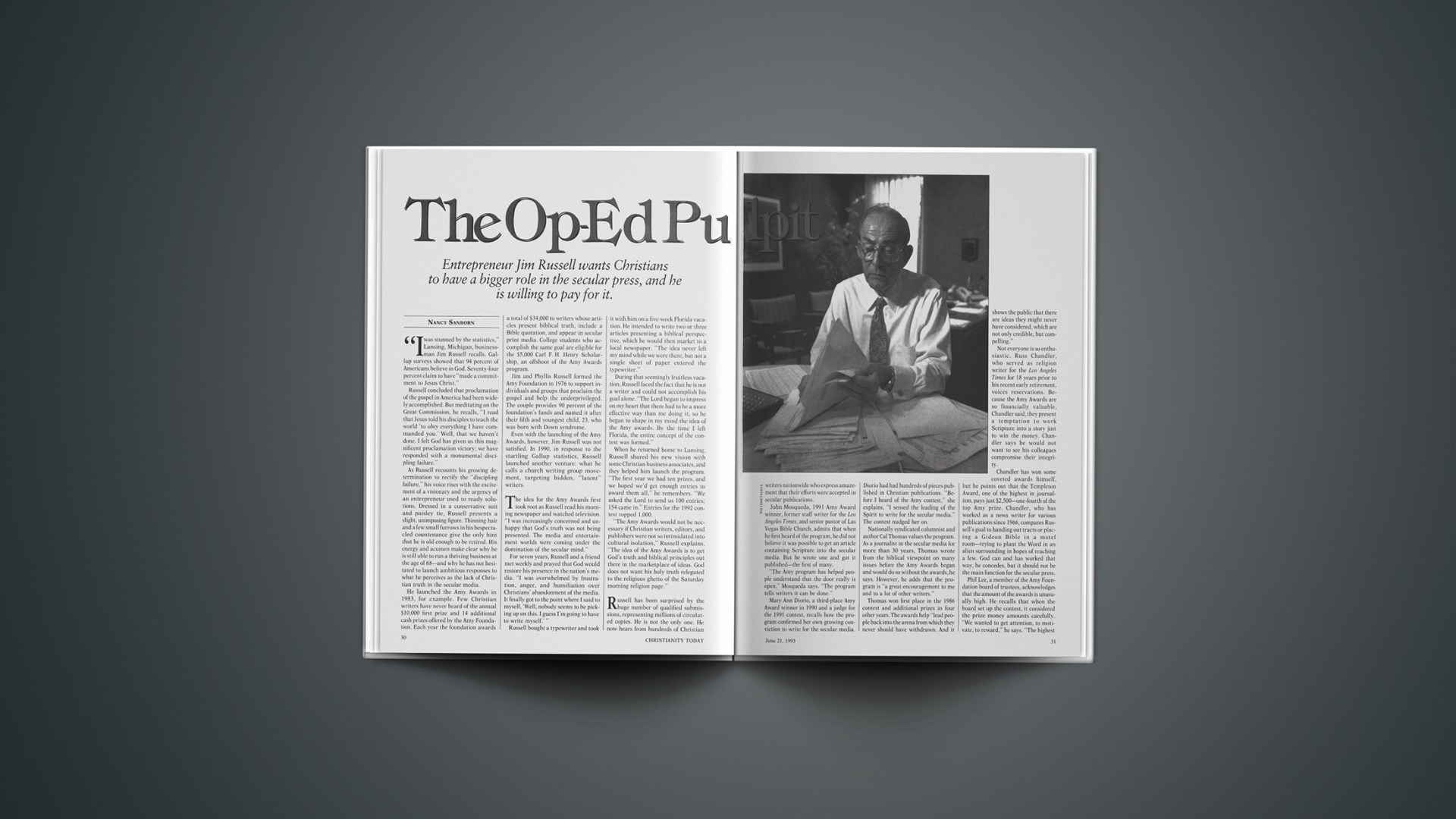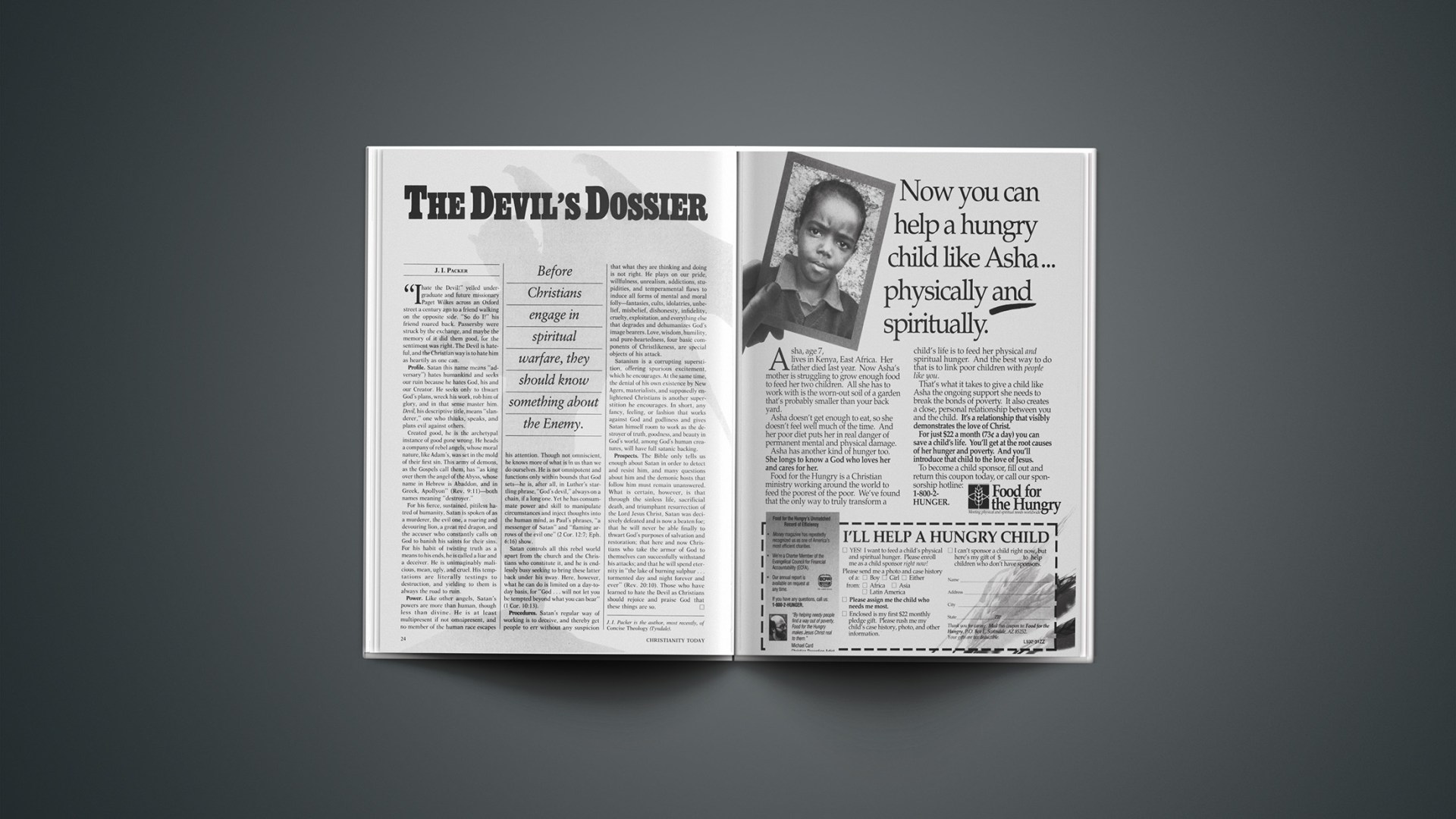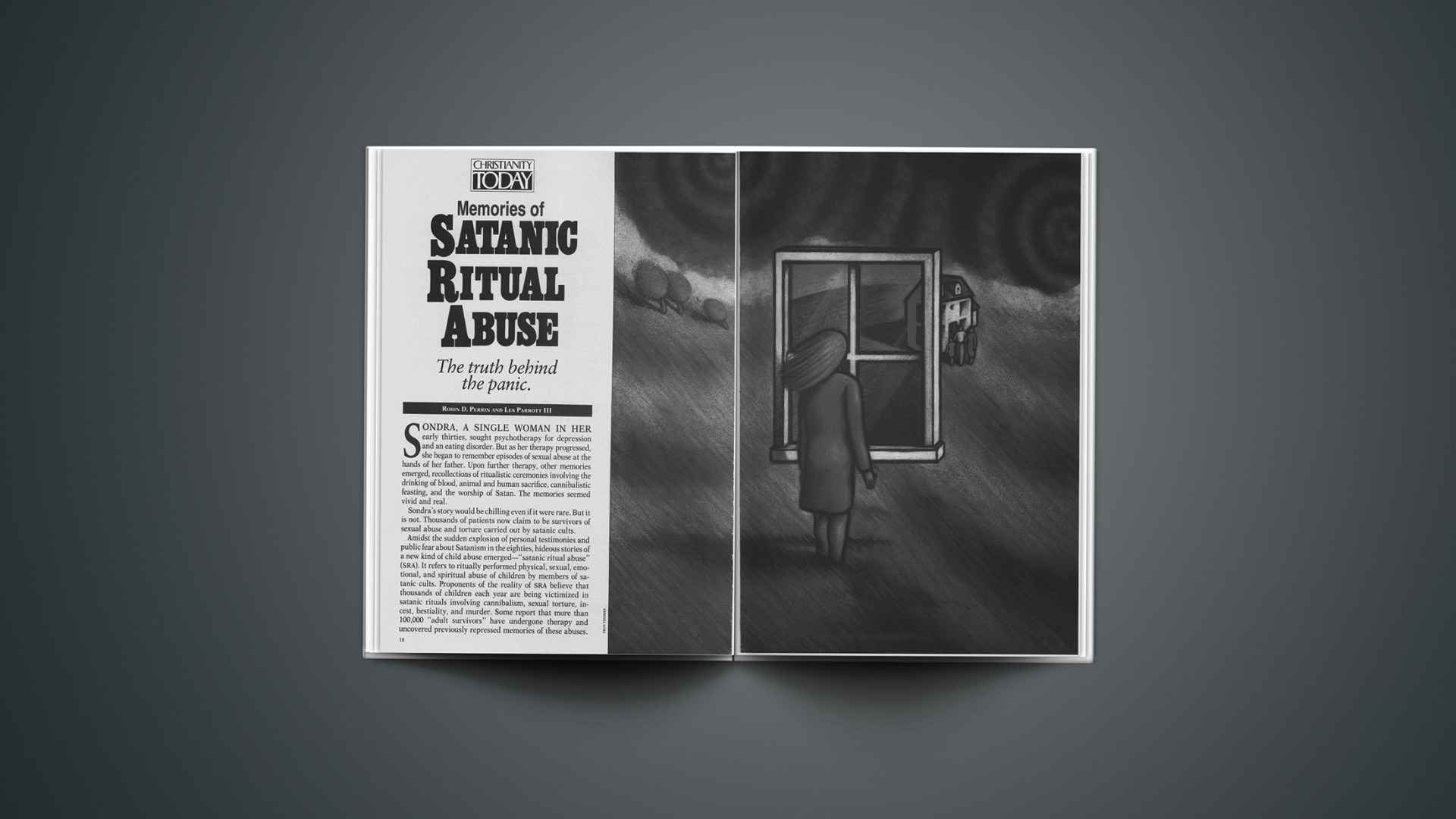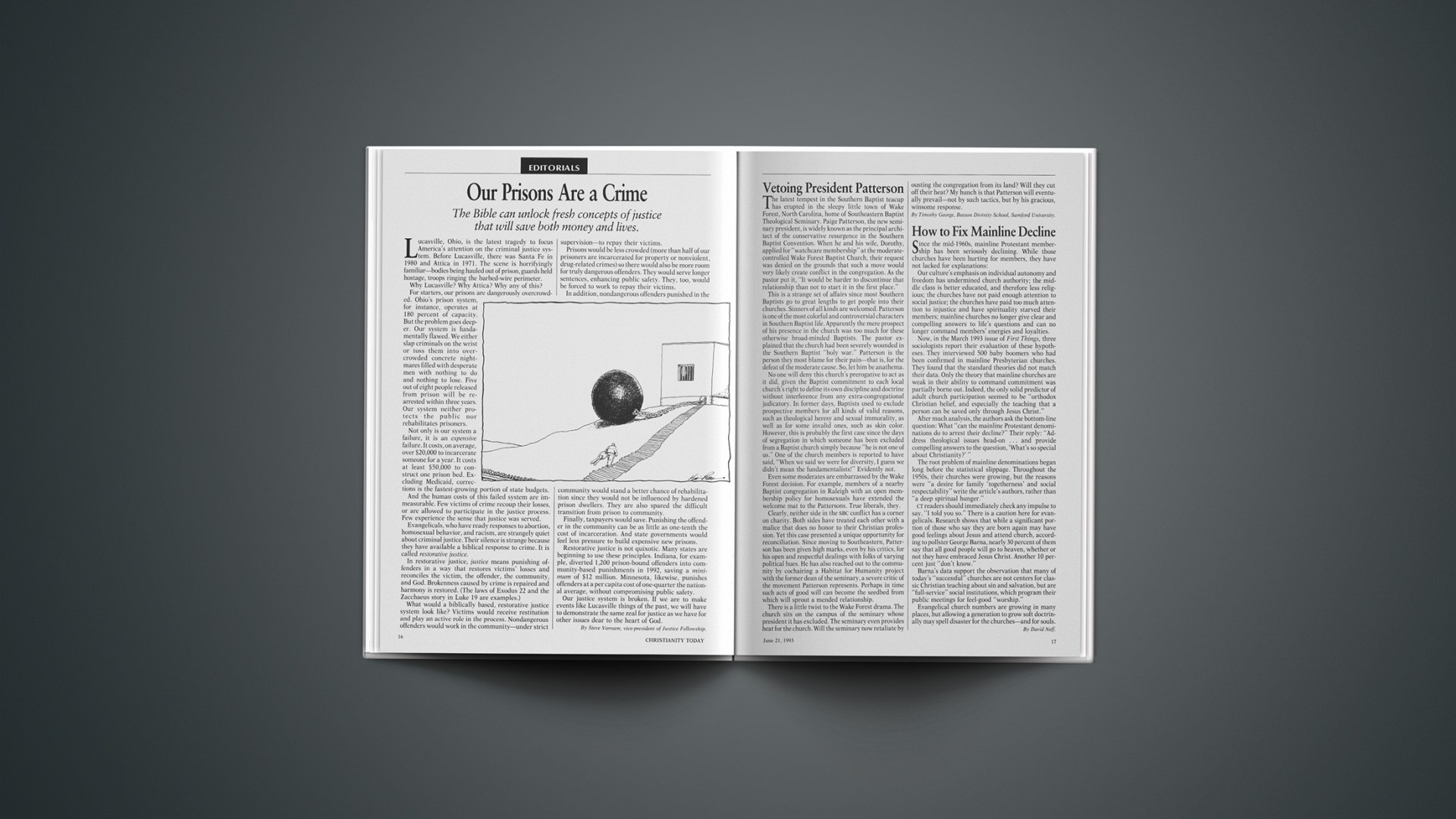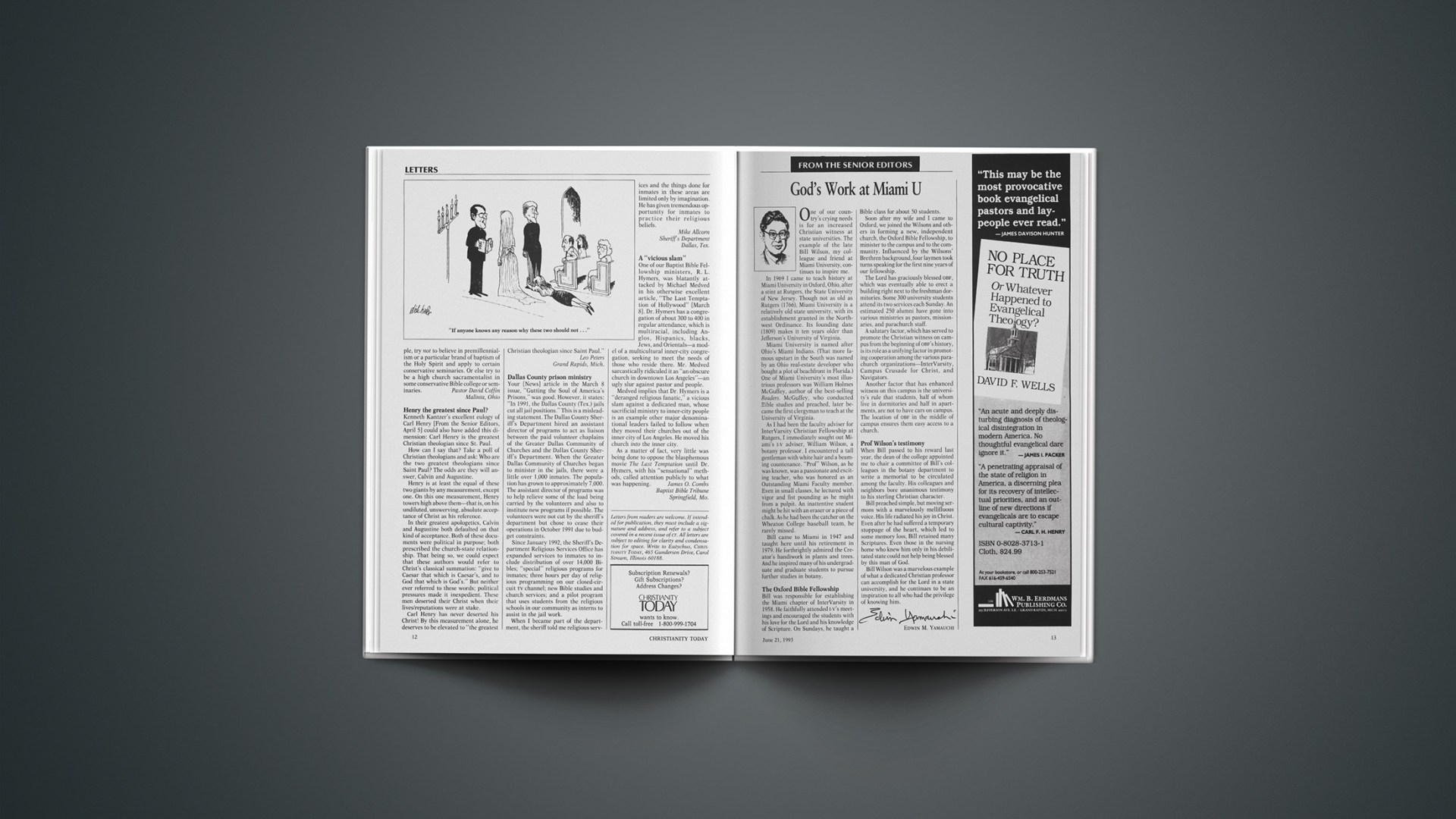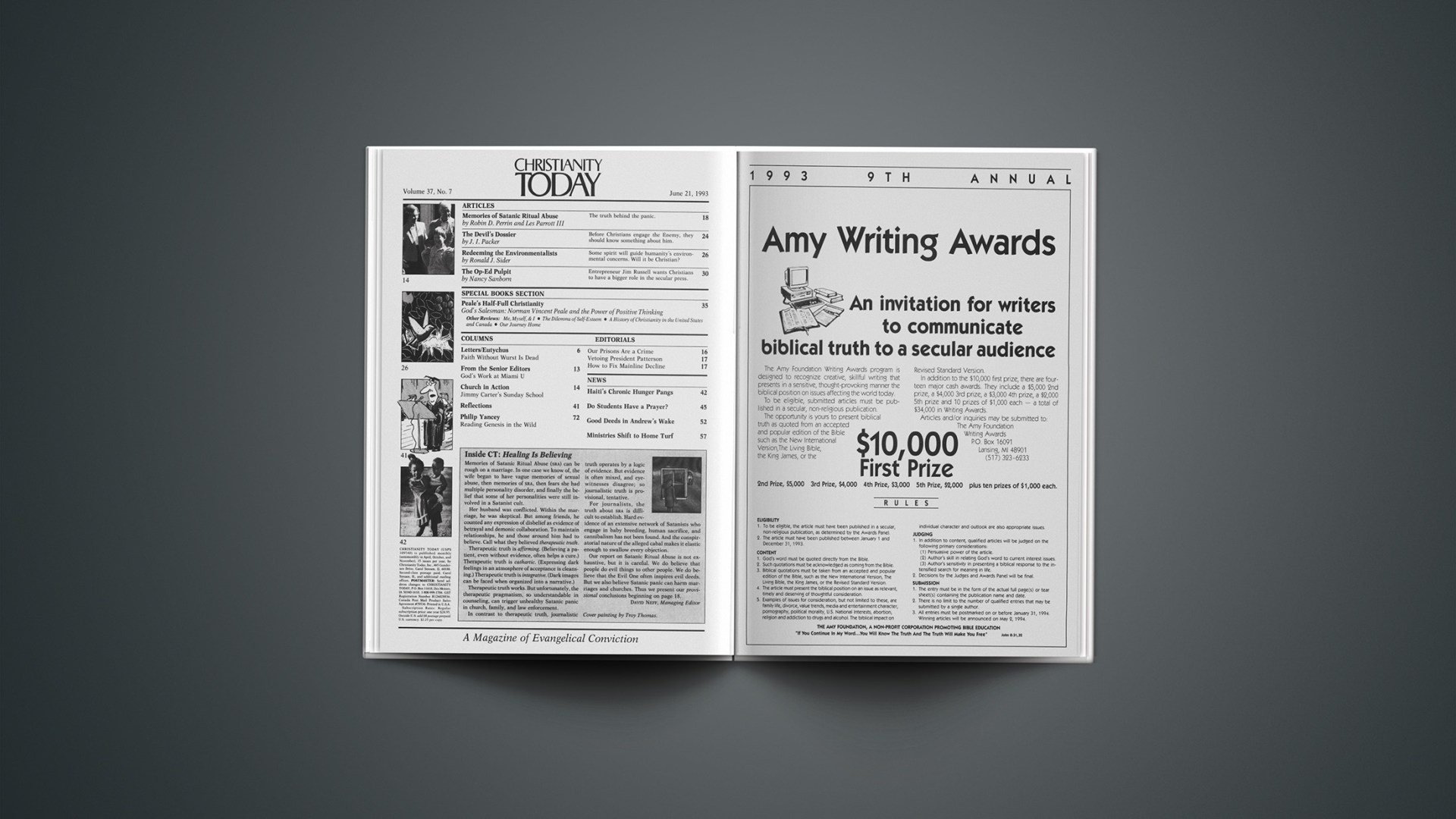Half-Full Christianity
God’s Salesman: Norman Vincent Peale and the Power of Positive Thinking,by Carol V. R. George (Oxford, 269 pp.; $23, hardcover). Reviewed by Tim Stafford
“I have been accused of belonging to both branches [fundamentalist and modernist],” Norman Vincent Peale said in a sermon preached in the early sixties, “and that is a fact, I do.” That might sound like political squishiness, trying to please everybody at once. But as historian Carol George shows in her thoughtful and scholarly biography, Peale’s claim was true.
Peale has belonged to both and neither party, because he represented something genuinely new: the first example of nondenominational, entrepreneurial, communications-savvy, pragmatic, populist religion that rose out of the fundamentalist-modernist split.
Conservative Protestants have suspected him because his “power of positive thinking” was human-centered and biblically vague. Liberals have liked him even less, for he has been politically incorrect, sentimental, and unscholarly—and most of all, because he has challenged the highbrow, institutional religion they stood for. Today Peale and his “power of positive thinking” may seem tame and grandfatherly, but in his heyday he was a lightning rod for controversy. Peale broke ground for major changes in American religious life—changes we are still working out.
Also reviewed in this section: Me, Myself, & I, by Archibald D. Hart; The Dilemma of Self-Esteem, by Joanna and Alister McGrath; A History of Christianity in the United States and Canada, by Mark A. Noll; Our Journey Home, by Gary Bauer
The first entrepreneur
Born in the nineteenth century, Peale grew up the son of a Methodist pastor who loved Dwight L. Moody’s old-time gospel. The small-town Ohio churches of Norman’s boyhood emphasized revivals, altar calls, and Prohibition. Peale never lost his sense of Wesleyan piety. This biography mentions three “conversion” experiences subsequent to his boyhood one: on a 1934 trip to Keswick, England; during Billy Graham’s 1957 New York Crusade; and late in life, while watching evangelist Rex Humbard on television.
Peale’s greatest struggle, however, was not with God but with himself. As a boy he had a deep-seated inferiority complex and was extremely sensitive to criticism. He prayed about it fervently and drove himself into a variety of sales jobs. All through his life, dark fears contended with his sunny exterior.
At Ohio Wesleyan University—then still very much a church school—he read the works of William James and Ralph Waldo Emerson and was profoundly impressed by their hopeful interpretation of individual, psychological power. Boston University’s School of Theology exposed him to the reigning liberal theology. He disliked seminary intensely: he was never an abstract thinker and had a hard time seeing how “philosophy” would further the church’s ministry. Nevertheless, he began his pastoral work identifying himself as a liberal.
What distinguished his early pastorates, however, was hard work, especially in preparing his sermons and newspaper advertisements. He learned to communicate with the grassroots in a whole new way.
“I’m a conservative,” he told John Sherrill of Guideposts in an interview years later, “and I will tell you exactly what I mean by that. I mean that I have accepted the Lord Jesus Christ as my personal Savior. I mean that I believe my sins are forgiven by the atoning work of grace on the cross.… Now I’ll tell you something else.… I personally love and understand this way of stating the Christian gospel. But I am absolutely and thoroughly convinced that it is my mission never to use this language in trying to communicate with the audience that God has given me.”
At the age of 34, with a reputation as a dynamic pastor whose churches grew, Peale accepted a call to the Marble Collegiate Church in Manhattan. It had a large, historic building, a sizable endowment, but a small and discouraged congregation. He stayed for 52 years, building the church’s size and strength through the Depression, and seeing days in the fifties when tourists lined up on the streets to hear him preach. Peale was an innovator, launching a groundbreaking clinic for Christian psychotherapy, and starting Guideposts, the largest-circulation religious publication of our time.
Most important, he perfected his simplification of the gospel in the 1952 best-selling The Power of Positive Thinking. At last count, it had sold 15 million copies. Its format has been followed in thousands of self-help books since: numerous inspirational anecdotes and a few catchy, religio-psychological phrases. “Picturize, prayerize, actualize” was Peale’s key formula.
The book, for all its success, was savaged by liberal theologians in a way that is almost incomprehensible today. They hurt Peale deeply. In many ways, he was following the liberal path, adapting the kerygma of the gospel to modern ways of thinking.
His populism offended the theological Brahmins, however, as did his politics. They wanted a gospel that restructured society; he wanted to help the solitary individual who felt overwhelmed by modern life. They thought he was hijacking the church they controlled, remaking it to the tastes of the masses. They also disdained Peale’s conservative Republicanism; he took an active role (with several evangelicals) in opposing John F. Kennedy’s election on the grounds that he was a Roman Catholic. (Politically conservative evangelicals should read of the despair that swept over Peale and his allies at the election of Kennedy and, before him, Roosevelt. It might put their feelings about Bill Clinton in perspective.)
Connection or compromise?
Norman Vincent Peale is a devout Christian, who injected vitality into a church that was losing touch with ordinary Americans—with the salesmen and housewives and schoolteachers who found him so inspirational. Peale spoke their language, much as televangelists and megachurch pastors who followed him have done. But did he pay too high a price to connect?
Peale always believed his message was biblical, but it lacked much reference to sin, to atonement, or, indeed, to an incarnation. The Christ he preached was very like AA founder Bill Wilson’s ambiguous Higher Power.
How one evaluates Peale is probably an index of how one evaluates modern American Christianity. Nearly every facet of Peale’s work—his conservative politics, his individualistic, self-improving message, his concern for the power of the mind and its potential to transform life and health, his interest in modern communications and in numerical growth—has become dominant in the modern church. He was, like Christopher Columbus, a pathfinder, and all kinds of people have followed him into the new world of free-enterprise religion.
Whether we like it or not, we cannot return to the solid, orthodox, rural America Peale came from. We have to cultivate the new world, to make it produce good fruit. Unfortunately, Peale’s career offers few clues on how to do so. It is a telling close to Peale’s life that after retirement from the pastorate, he devoted nearly all his time to motivational speaking at business meetings. Peale is a man with a message about power: the power of our thoughts, which he believes releases the power of God. The message, however, is easily detached from a setting where people might worship God or say a creed; the church of Pealism ultimately requires only the lively spirits of a banquet room.
The Troubled Self
Me, Myself, & I: How Far Should We Go in Our Search for Self-Fulfillment?by Archibald D. Hart (Servant, 252 pp.; $10.99, paper).The Dilemma of Self-Esteem: The Cross and Christian Confidence,by Joanna and Alister McGrath (Crossway, 156 pp.; $8.99, paper). Reviewed by Robert C. Roberts, professor of philosophy and psychological studies at Wheaton College and the author of Taking the Word to Heart (Eerdmans).
The church has a love-hate relationship with psychology. To those who lean toward hate, the psychologist is the thief in shepherd’s clothing, one who comes in the name of health and guidance but in reality kills the soul and destroys the faith of God’s lambs. They think that in the place of God, psychology sets the human self; and in place of loving God and neighbor, psychology promotes self-esteem. The other side sees psychology (the science of the soul) as the key to a correct reading of what is central to the Christian message. That message is surely about health, salvation, well-being—in particular, the health and salvation of the soul—and that is exactly what psychology offers, supported by scientific research and professional expertise.
For a third group of Christians, the love and the hate are found within a single heart: We see there is much good to be derived from psychology, but we are appalled by what it sometimes does to people, replacing the profound shape of the Christian spiritual life with something that by comparison seems meager, cheap, and shallow. We are confused, unsure of what we are to make of psychology.
Redeeming psychology
Some answers can be found in two recent and remarkably similar works: Me, Myself, and I, by Archibald Hart, a professor at Fuller seminary’s Graduate School of Psychology; and The Dilemma of Self-Esteem, by Joanna McGrath, a British psychologist, and her Oxford University theologian-husband, Alister McGrath. All three authors recognize the danger of too facile an “integration” of psychology and psychotherapy into the life of the church; yet they think some of the methods of psychology and some of its goals (rightly interpreted) can be adopted for Christian use.
Against the antipsychology sentiment in the church (which sees the self only as a barrier to proper spirituality), these authors hold that the self is, in itself, something to be nurtured, not feared or rejected. They affirm that self-esteem, rightly understood, is to be promoted, both in counseling and from the pulpit, as part of that nurture.
It is integral to the project of both books to reject a kind of “dualism” between psychology and Christianity that says that people have two kinds of needs—emotional and spiritual—and that psychology deals with our emotional side while Christianity meets our spiritual needs. Instead, Hart and the McGraths insist that the emotional and the spiritual are entangled with each other in complicated ways.
They suggest that the self needs to be viewed in ways that are seldom understood by non-Christian psychologists. For instance, Christians see the self as created in the image of God for obedient fellowship with God and loving service to others. Self-fulfillment, then, is not something “selfish” but is the actualization of the “human potential” for worship, obedience, and service.
Hart and the McGraths criticize secular psychology for its failure to acknowledge human sin. Consequently, any concept of self-esteem fostered by such psychology will be unrealistic, tending to gloss over or misinterpret the dark side of the human heart.
All three authors are uneasy with talking about “high” and “low” self-esteem, as though self-esteem is some one quantifiable value. Rather, self-esteem comes in different kinds, they argue, and the Christian psychologist encourages self-esteem that is “appropriate” or “healthy” according to Christian standards. A self-esteem in which the individual experiences herself as attached to, and dependent on, Christ differs greatly from the kind promoted in Rogerian psychology, which has no notion of sin and aims to detach the individual from other persons with whom she may be close.
The McGraths find the basis for Christian self-esteem in Luther’s (and Paul’s) notion that Christians are simultaneously righteous in Christ and sinners in themselves. Thus our esteem is grounded not in what we do or even in who we are, but in someone who transcends all that we do or can do.
What’s right with Freud
In light of the differences between Christian and secular psychology, why shouldn’t Christians just get their psychology out of the Bible? Hart and the McGraths argue that there is much of value in secular psychology, although they do not limit themselves to any particular school (Freudian, Jungian, cognitive behavioral, Rogerian, etc.).
The McGraths lean toward cognitive behavioral psychology since it has been unusually successful in treating depression, which is closely related to self-esteem issues. Cognitive psychology emphasizes how a person thinks about himself, and therapy consists largely of trying to give the client healthier ways of thinking. For millennia, Christians have tried, through discipling and preaching, to change people by getting them to think differently about themselves. Cognitive psychologists like Aaron Beck have done a lot of research on cognition, emotional states, and on techniques of talking to clients from which Christians can learn. Similarly, the neo-Freudians, toward whom Hart leans, have increased our understanding of the role of early childhood in the development of personality and self-esteem.
Both of the books are written at a fairly popular level, with quite a bit of anecdote and repetition, but both are informative and based on solid training, theological understanding, and therapeutic experience. The McGraths’ book is somewhat more succinct and tightly reasoned; Hart’s is more chatty and punctuated with anecdotes.
Hart’s subtitle is misleading. The question is not, “How far should we go in our search for self-fulfillment?” for his answer is surely that we should go all the way to fulfillment in Jesus Christ. The question is rather, What is the self that is up for fulfillment in Christianity, and what are the barriers to and methods for attaining this fulfillment? The issue is not quantitative; it is about the quality of our lives, the character of our souls.
The Rise And Fall Of Protestant America
A History of Christianity in the United States and Canada,by Mark A. Noll (Eerdmans, xvi + 576 pp.; $39.95, hardcover; $29.95, paper). Reviewed by Kevin A. Miller, editor of CHRISTIAN HISTORY magazine.
Twenty-one years ago, Sydney E. Ahlstrom published his massive A Religious History of the American People. It won the American Book Award, became a standard classroom text, and frightened away most scholars from attempting anything similar. Now Mark Noll, McManis Professor of Christian Thought at Wheaton College, has ventured where historians feared to tread: he has written, in effect, an Ahlstrom for the nineties.
Noll’s History differs in important ways. First, Noll focuses on distinctly Christian, rather than religious, events. (Christian, though, is defined more culturally than theologically; thus, Mormons receive treatment.)
O Canada
More important, Noll ventures north of the border. He traces the path of Christianity not only in the U.S. but also in Canada, a story virtually unknown to American evangelicals. From the Huguenots (French Protestants), who settled New France in the 1600s, to former Prime Minister Pierre Trudeau, who was influenced by Quebec’s Catholic labor movement, we find surprises. Did you know that Canadians founded the Christian and Missionary Alliance and wrote the famous gospel hymn “What a Friend We Have in Jesus”?
Interweaving American and Canadian experience bogs the narrative somewhat, yet it generally provides intriguing insights. For instance, Canada, with its strong Catholic presence, never had an overarching Protestant public culture, as did the United States in the early 1800s. Thus it never had a monolithic approach to public education. One result, Noll writes, is that “more Canadians than Americans have acknowledged that education is never value-neutral.” Today, in most provinces, religious minorities can receive government funds for their own religious primary and secondary schools. American evangelicals frustrated with a secularist mindset in many public schools could study the Canadian approach with interest.
Noll also provocatively argues that “Canada has an even better objective argument for being considered a ‘Christian nation’ than does the United States.”
Why? “Canada did not tolerate slavery, it has not thrown its weight around in foreign adventures, it has not done quite so poorly with its Native Americans, … its churches have much more … impact on local public life, it has cared more humanely for the poor and weak members of its society, and its educational structures make some provision for teaching religion.” Canada’s churches have their own problems, and Canadian society is rapidly becoming secular, but Noll’s point remains sharp: If you’re looking for “Christian America,” look north.
A religious wilderness
Canadians are not the only underreported minority Noll covers. He admits his book is “self-consciously influenced by important recent currents in the study of American religious history”:
• An emphasis on the religious experiences of the poor and working-class folk who generally did not leave written records. One way Noll incorporates their story is by including the texts of hymns, which even the poorest used to express their religious feelings.
• Considerable coverage of women and minorities. For example, Noll tells the “ambiguous” tale of Protestant missions to the Cherokees. In the early 1800s, Moravian, Presbyterian, and Baptist missionaries evangelized the Cherokees in parts of Georgia, North Carolina, and Tennessee. The Cherokees’ “slow but steady acceptance of the Christian faith” was violently halted when gold was found in northern Georgia and President Andrew Jackson forcibly removed the Cherokees to the West. Most missionaries went along with the crime. Some protested their nation’s action and were jailed.
• A focus wider than the Puritans in the early 1700s. Noll follows current scholarship in paying significant attention to other early shapers of American religion, such as the Quakers and Anglicans (Episcopalians).
• More attention to the nineteenth-century immigrants—Lutherans, Catholics, Orthodox—who transformed a largely Protestant American landscape.
But Noll’s History is more than merely trendy and comprehensive. It helps Christians place themselves. Where are North American believers today?
In Noll’s telling, the story might be titled “The Rise and Fall of Protestants in America.” Christians hewed out of the American wilderness a largely Protestant culture that dominated society. The Protestant mainstream “once dictated cultural values, provided standards for private and public morality, assumed primary responsibility for education, and powerfully shaped the media.” Oh, how the mighty have fallen! Today “Protestantism is fragmented and culturally feeble.”
When did American Protestants lose the field? In Noll’s view, “evangelical America” began to unravel at the Civil War and was completely undone by the 1920s. Today, he concludes, North America is a religious wilderness.
But the cloud has a silver lining. “Now, with these Christian establishments mostly a memory,” Noll writes, “churches may find it possible to concentrate more on the Source of Life than on the American Way of Life.” In other words, no longer able to wield a big political stick, North American Protestants may have to walk softly and rediscover their spiritual strength.
If America’s denominations have fallen back into a “religious wilderness,” though, how does Noll explain the incredibly high level of church adherence in the United States? As Roger Finke and Rodney Stark argue in The Churching of America, 1776–1990, “America shifted from a nation in which most people took no part in organized religion to a nation in which nearly two-thirds of American adults do.”
Noll would probably reply that in the States, “secularization … advances within the churches.” Still, Finke and Stark present evidence that the rise in American church membership was not accompanied by a decline in acceptance of doctrine or in commitment. The historians and sociologists will have to sift out how America can simultaneously be in a “religious wilderness” and a church-adherence revival.
Noll has given us a fine narrative history, probably the best available of Christianity in North America. And it is significant that it was written by an evangelical. Evangelical historians are now making their mark on the field of church history—especially on American religious history. Many of the best new books, grants, study centers, and journals are influenced or led by evangelicals. In few other academic circles can that be said.
Were Ozzie And Harriet Good Parents?
Our Journey Home: What Parents Are Doing to Preserve Family Values,by Gary Bauer (Word, 222 pp.; $15.99, hardcover). Reviewed by Mark A. Horne, a freelance writer and contributing editor to Legacy Communications.
In one sense, Gary Bauer is optimistic. In Our Journey Home he argues that family values are on the rise in America, that a decline begun in the fifties is slowly reversing. As the president of the Family Research Council (FRC), one of the most visible profamily lobbying groups in Washington, D.C., Bauer is well-qualified to make his case. He claims that antifamily elites in politics, entertainment, arts, and the media are ignoring and deriding a grassroots sexual counterrevolution.
Bauer cites a survey of a thousand Americans in which 61 percent of respondents said that things were much better in the fifties than they are today. Other polls and surveys are used to reveal the culture’s moral shift to the right.
A USA Today poll found that 63 percent of teens believe that safe-sex ads are dangerous because they might be interpreted as condoning casual sex; only 54 percent of adults felt that way. Could teenagers be getting more conservative than their parents?
After making his case for a resurgent grassroots conservatism, Bauer gives parents some commonsensible advice, urging them to be both caregivers and role models for their families. He includes a survey of what values parents should teach their children and a recommended list of “the literature of family, faith, and freedom.” These recommendations range from the fiction of C. S. Lewis to the Federalist Papers. Unfortunately, this last section is one of the shorter chapters in the book.
More than nostalgia
Despite some surprising information, Our Journey Home is, on the whole, unconvincing. Bauer’s optimism about the outlook for family values is based on what he claims is a grassroots change in thinking. He assumes such a trend will eventually be reflected in legislation, public education, and other areas of life under the dominion of politics.
The assumption is dubious. Conservatives are, by nature, handicapped in politics. Bauer as much as admits this when he talks of “cultural elites.” Husbands and wives struggling financially to support a family and raise civilized children are rarely in a position to become activists, to lobby the government, or to get heavily involved in the school board. As a result, those who do have the time and inclination for the pursuit of politics may not represent those who live by family values.
Another problem is that the book aims too low. Despite Bauer’s statistics, much of the book’s content is anecdotal and much of the book’s force depends on arousing nostalgia in the reader. Bauer insists on holding up as ideal the patriotic action of the forties and the suburban lifestyles of the fifties.
It is an undeniable fact of history, however, that American involvement in World War II severely undermined family values. Whether one considers the army-run brothels under General Patton in Europe or the intense government propaganda luring wives into war factories, it is obvious the values of that time were nationalistic at the expense of the family.
Once the war was over, men and women were ready to settle down. Nevertheless, the permissive society was here to stay. The children these families produced in the fifties spawned the “sexual revolution” of the sixties. After all, if the families of the fifties were so conservative, how did the culture change so suddenly?
To present an optimistic vision for the future, we need a better model than the fifties. We need something that can last.



